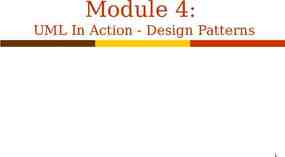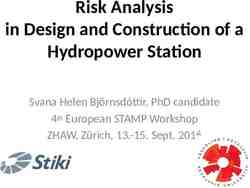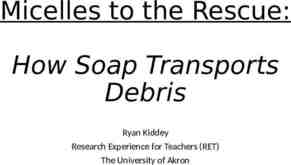CSCI 211 Computer System Architecture Lec 8
52 Slides383.50 KB

CSCI 211 Computer System Architecture Lec 8 – Multiprocessor Introduction Xiuzhen Cheng Department of Computer Sciences The George Washington University Adapted from the slides by Dr. David Patterson @ UC Berkeley

Outline MP Motivation SISD v. SIMD v. MIMD Centralized vs. Distributed Memory Challenges to Parallel Programming Consistency, Coherency, Write Serialization Write Invalidate Protocol Example Performance of SMP Conclusion 05/03/24 Csci 211 – Lecture 8 2

Uniprocessor Performance (SPECint) 3X Performance (vs. VAX-11/780) 10000 1000 From Hennessy and Patterson, Computer Architecture: A Quantitative Approach, 4th edition, 2006 20%/year 52%/year 100 10 25%/year 1 1978 1980 1982 1984 1986 1988 1990 1992 1994 1996 1998 2000 2002 2004 2006 VAX : 25%/year 1978 to 1986 RISC x86: 52%/year 1986 to 2002 05/03/24 Csci 211 – Lecture 8 RISC x86: 20%/year 2002 to present 3

Déjà vu all over again? “ today’s processors are nearing an impasse as technologies approach the speed of light.” David Mitchell, The Transputer: The Time Is Now (1989) Transputer (concurrent computing microprocessor) had bad timing (Uniprocessor performance ) Procrastination rewarded: 2X seq. perf. / 1.5 years “We are dedicating all of our future product development to multicore designs. This is a sea change in computing” Paul Otellini, President, Intel (2005) All microprocessor companies switch to MP (2X CPUs / 2 yrs) Procrastination penalized: 2X sequential perf. / 5 yrs AMD/’05 Intel/’06 IBM/’04 Sun/’05 Processors/chip 2 2 2 8 Threads/Processor 1 2 2 4 Threads/chip 2 4 4 32 Manufacturer/Year 05/03/24 Csci 211 – Lecture 8 4

Other Factors Multiprocessors Growth in data-intensive applications – Data bases, file servers, Growing interest in servers, server perf. Increasing desktop perf. less important – Outside of graphics Improved understanding in how to use multiprocessors effectively – Especially server where significant natural TLP Advantage of leveraging design investment by replication – Rather than unique design 05/03/24 Csci 211 – Lecture 8 5

Flynn’s Taxonomy M.J. Flynn, "Very High-Speed Computers", Proc. of the IEEE, V 54, 1900-1909, Dec. 1966. Flynn classified by data and control streams in 1966 Single Instruction Single Data (SISD) (Uniprocessor) Single Instruction Multiple Data SIMD (single PC: Vector, CM-2) Multiple Instruction Single Data (MISD) (?) Multiple Instruction Multiple Data MIMD (Clusters, SMP servers) SIMD Data Level Parallelism MIMD Thread Level Parallelism MIMD popular because – Flexible: N pgms and 1 multithreaded pgm – Cost-effective: same MPU in desktop & MIMD 05/03/24 Csci 211 – Lecture 8 6

Back to Basics “A parallel computer is a collection of processing elements that cooperate and communicate to solve large problems fast.” Parallel Architecture Computer Architecture Communication Architecture 2 classes of multiprocessors WRT memory: 1. Centralized Memory Multiprocessor few dozen processor chips (and 100 cores) in 2006 Small enough to share single, centralized memory 2. Physically Distributed-Memory multiprocessor Larger number chips and cores. BW demands Memory distributed among processors 05/03/24 Csci 211 – Lecture 8 7

Centralized vs. Distributed Memory Scale P1 Pn Pn P1 Mem Mem Inter connection network Inter connection network Mem Mem Centralized Memory 05/03/24 Distributed Memory Csci 211 – Lecture 8 8

Centralized Memory Multiprocessor Also called symmetric multiprocessors (SMPs) because single main memory has a symmetric relationship to all processors Large caches single memory can satisfy memory demands of small number of processors Can scale to a few dozen processors by using a switch and by using many memory banks Although scaling beyond that is technically conceivable, it becomes less attractive as the number of processors sharing centralized memory increases 05/03/24 Csci 211 – Lecture 8 9

Distributed Memory Multiprocessor Pro: Cost-effective way to scale memory bandwidth If most accesses are to local memory Pro: Reduces latency of local memory accesses Con: Communicating data between processors more complex Con: Requires more effort in software to take advantage of increased memory BW 05/03/24 Csci 211 – Lecture 8 10

2 Models for Communication and Memory Architecture 1. Communication occurs by explicitly passing messages among the processors: message-passing multiprocessors 2. Communication occurs through a shared address space (via loads and stores): shared memory multiprocessors either UMA (Uniform Memory Access time) for shared address, centralized memory MP NUMA (Non Uniform Memory Access time multiprocessor) for shared address, distributed memory MP In past, confusion whether “sharing” means sharing physical memory (Symmetric MP) or sharing address space 05/03/24 Csci 211 – Lecture 8 11

Challenges of Parallel Processing First challenge is % of program inherently sequential Suppose 80X speedup from 100 processors. What fraction of original program can be sequential? a. 10% b.5% c. 1% d. 1% 05/03/24 Csci 211 – Lecture 8 12

Challenges of Parallel Processing Second challenge is long latency to remote memory Suppose 32 CPU MP, 2GHz, 200 ns remote memory, all local accesses hit memory hierarchy and base CPI is 0.5. (Remote access 200/0.5 400 clock cycles.) What is performance impact if 0.2% instructions involve remote access? a. 1.5X b. 2.0X c. 2.5X 05/03/24 Csci 211 – Lecture 8 14

Challenges of Parallel Processing 1. Application parallelism primarily via new algorithms that have better parallel performance 2. Long remote latency impact both by architect and by the programmer For example, reduce frequency of remote accesses either by – Caching shared data (HW) – Restructuring the data layout to make more accesses local (SW) Today’s lecture on HW to help latency via caches 05/03/24 Csci 211 – Lecture 8 16

Symmetric Shared-Memory Architectures From multiple boards on a shared bus to multiple processors inside a single chip Caches both – Private data are used by a single processor – Shared data are used by multiple processors Caching shared data reduces latency to shared data, memory bandwidth for shared data, and interconnect bandwidth cache coherence problem 05/03/24 Csci 211 – Lecture 8 17

Example Cache Coherence Problem P2 P1 u ? P3 3 u ? 4 5 u :5 u 7 u :5 I/O devices 1 u :5 2 Memory – Processors see different values for u after event 3 – Write back cache – Write through cache 05/03/24 Csci 211 – Lecture 8 18

Intuitive Memory Model P L1 100:67 L2 100:35 Memory Disk 100:34 Reading an address should return the last value written to that address – Easy in uniprocessors, except for I/O Too vague and simplistic; 2 issues 1. Coherence defines values returned by a read 2. Consistency determines when a written value will be returned by a read 05/03/24 Csci 211 – Lecture 8 19

Defining Coherent Memory System 1. Preserve Program Order: A read by processor P to location X that follows a write by P to X, with no writes of X by another processor occurring between the write and the read by P, always returns the value written by P 2. Coherent view of memory: Read by a processor to location X that follows a write by another processor to X returns the written value if the read and write are sufficiently separated in time and no other writes to X occur between the two accesses 3. Write serialization: 2 writes to same location by any 2 processors are seen in the same order by all processors – If not, a processor could keep value 1 since saw as last write – For example, if the values 1 and then 2 are written to a location, processors can never read the value of the location as 2 and then later read it as 1 05/03/24 Csci 211 – Lecture 8 20

Write Consistency For now assume 1. A write does not complete (and allow the next write to occur) until all processors have seen the effect of that write 2. The processor does not change the order of any write with respect to any other memory access if a processor writes location A followed by location B, any processor that sees the new value of B must also see the new value of A These restrictions allow the processor to reorder reads between two writes, but forces the processor to finish writes in program order 05/03/24 Csci 211 – Lecture 8 21

Basic Schemes for Enforcing Coherence Program on multiple processors will normally have copies of the same data in several caches – Unlike I/O, where its rare Rather than trying to avoid sharing in SW, SMPs use a HW protocol to maintain coherent caches – Migration and Replication key to performance of shared data Migration - data can be moved to a local cache and used there in a transparent fashion – Reduces both latency to access shared data that is allocated remotely and bandwidth demand on the shared memory Replication – for shared data being simultaneously read, since caches make a copy of data in local cache – Reduces both latency of access and contention for read shared data 05/03/24 Csci 211 – Lecture 8 22

2 Classes of Cache Coherence Protocols 1. Directory based — Sharing status of a block of physical memory is kept in just one location, the directory 2. Snooping — Every cache with a copy of data also has a copy of sharing status of block, but no centralized state is kept All caches are accessible via some broadcast medium (a bus or switch) All cache controllers monitor or snoop on the medium to determine whether or not they have a copy of a block that is requested on a bus or switch access 05/03/24 Csci 211 – Lecture 8 23

Snoopy Cache-Coherence Protocols State Address Data P1 Pn Bus snoop Mem I/O devices Cache-memory transaction Cache Controller “snoops” all transactions on the shared medium (bus or switch) – relevant transaction if for a block it contains – take action to ensure coherence » invalidate, update, or supply value – depends on state of the block and the protocol Either get exclusive access before write via write invalidate or update all copies on write 05/03/24 Csci 211 – Lecture 8 24

Example: Write-thru Invalidate P2 P1 u ? P3 3 u ? 4 5 u :5 u 7 u :5 I/O devices 1 u :5 2 u 7 Memory Must invalidate before step 3 Write update uses more broadcast medium BW all recent MPUs use write invalidate 05/03/24 Csci 211 – Lecture 8 25

Architectural Building Blocks Cache block state transition diagram – FSM specifying how disposition of block changes » invalid, valid, dirty Broadcast Medium Transactions (e.g., bus) – Fundamental system design abstraction – Logically single set of wires connect several devices – Protocol: arbitration, command/addr, data Every device observes every transaction Broadcast medium enforces serialization of read or write accesses Write serialization – 1st processor to get medium invalidates others copies – Implies cannot complete write until it obtains bus – All coherence schemes require serializing accesses to same cache block Also need to find up-to-date copy of cache block 05/03/24 Csci 211 – Lecture 8 26

Locate up-to-date copy of data Write-through: get up-to-date copy from memory – Write through simpler if enough memory BW Write-back harder – Most recent copy can be in a cache Can use same snooping mechanism 1. Snoop every address placed on the bus 2. If a processor has dirty copy of requested cache block, it provides it in response to a read request and aborts the memory access – Complexity from retrieving cache block from a processor cache, which can take longer than retrieving it from memory Write-back needs lower memory bandwidth Support larger numbers of faster processors 05/03/24 Csci 211 – Lecture Most multiprocessors use8write-back 27

Cache Resources for WB Snooping Normal cache tags can be used for snooping Valid bit per block makes invalidation easy Read misses easy since rely on snooping Writes Need to know whether any other copies of the block are cached – No other copies No need to place write on bus for WB – Other copies Need to place invalidate on bus 05/03/24 Csci 211 – Lecture 8 28

Cache Resources for WB Snooping To track whether a cache block is shared, add extra state bit associated with each cache block, like valid bit and dirty bit – Write to Shared block Need to place invalidate on bus and mark cache block as private (if an option) – No further invalidations will be sent for that block – This processor called owner of cache block – Owner then changes state from shared to unshared (or exclusive) 05/03/24 Csci 211 – Lecture 8 29

Cache behavior in response to bus Every bus transaction must check the cacheaddress tags – could potentially interfere with processor cache accesses A way to reduce interference is to duplicate tags – One set for caches access, one set for bus accesses Another way to reduce interference is to use L2 tags – Since L2 less heavily used than L1 Every entry in L1 cache must be present in the L2 cache, called the inclusion property – If Snoop gets a hit in L2 cache, then it must arbitrate for the L1 cache to update the state and possibly retrieve the data, which usually requires a stall of the processor 05/03/24 Csci 211 – Lecture 8 30

Example Protocol Snooping coherence protocol is usually implemented by incorporating a finite-state controller in each node Logically, think of a separate controller associated with each cache block – That is, snooping operations or cache requests for different blocks can proceed independently In implementations, a single controller allows multiple operations to distinct blocks to proceed in interleaved fashion – that is, one operation may be initiated before another is completed, even through only one cache access or one bus access is allowed at time 05/03/24 Csci 211 – Lecture 8 31

Ordering P0: R P1: R P2: R R R R R W R R R R R R R W R R Writes establish a partial order Doesn’t constrain ordering of reads, though shared-medium (bus) will order read misses too – any order among reads between writes is fine, as long as in program order 05/03/24 Csci 211 – Lecture 8 32

Example Write Back Snoopy Protocol Invalidation protocol, write-back cache – Snoops every address on bus – If it has a dirty copy of requested block, provides that block in response to the read request and aborts the memory access Each memory block is in one state: – Clean in all caches and up-to-date in memory (Shared) – OR Dirty in exactly one cache (Exclusive) – OR Not in any caches Each cache block is in one state (track these): – Shared : block can be read – OR Exclusive : cache has only copy, its writeable, and dirty – OR Invalid : block contains no data (in uniprocessor cache too) Read misses: cause all caches to snoop bus Writes to clean blocks are treated as misses 05/03/24 Csci 211 – Lecture 8 33

Write-Back State Machine - CPU CPU Read hit State machine for CPU requests for each cache block Non-resident blocks invalid Invalid CPU Read Place read miss on bus Shared (read/only) CPU Write Place Write Miss on bus Cache Block State CPU read hit CPU write hit 05/03/24 CPU Write Place Write Miss on Bus Exclusive (read/write) CPU Write Miss (?) Write back cache block Csci 211 – Lecture 8 Place write miss on bus 34

Write-Back State Machine- Bus request State machine for bus requests for each cache block Invalid Write miss for this block Write Back Block; (abort memory access) Exclusive (read/write) 05/03/24 Csci 211 – Lecture 8 Write miss for this block Shared (read/only) Read miss for this block Write Back Block; (abort memory access) 35

Block-replacement CPU Read hit State machine for CPU requests for each cache block Invalid CPU Read Place read miss on bus Shared (read/only) CPU Write Place Write Miss on bus Cache Block State CPU read hit CPU write hit 05/03/24 CPU read miss CPU Read miss Write back block, Place read miss Place read miss on bus on bus CPU Write Place Write Miss on Bus Exclusive (read/write) CPU Write Miss Write back cache block Place write miss on bus Csci 211 – Lecture 8 36

Write-back State Machine-III CPU Read hit State machine for CPU requests for each cache block and for bus requests for each cache block Write miss for this block Shared CPU Read Invalid (read/only) Place read miss on bus CPU Write Place Write Miss on bus Write miss CPU read miss CPU Read miss for this block Write back block, Place read miss Write Back Place read miss on bus CPU Write Block; (abort on bus Place Write Miss on Bus memory access) Cache Block State CPU read hit CPU write hit 05/03/24 Exclusive (read/write) Read miss for this block Write Back Block; (abort memory access) CPU Write Miss Write back cache block Place write miss on bus Csci 211 – Lecture 8 37

Example step P1 P1:Write Write 10 10 to to A1 P1:P1: Read A1A1 Read P2: P2: Read A1 P1 State Addr Value P2 State Addr Bus Value Action Proc. Addr Memory Value Addr Value P2: P2: Write Write 20 to to A1 A1 P2: to A2 A2 P2: Write Write 40 to Assumes A1 and A2 map to same cache block, initial cache state is invalid 05/03/24 Csci 211 – Lecture 8 38

Example step P1 P1:Write Write 10 10 to to A1 P1:P1: Read A1A1 Read P2: P2: Read A1 P1 State Excl. Addr A1 Value 10 P2 State Addr Bus Value Action Proc. Addr WrMs P1 A1 Memory Value Addr Value P2: P2: Write Write 20 to to A1 A1 P2: A2 P2: Write Write 40 to to A2 Assumes A1 and A2 map to same cache block 05/03/24 Csci 211 – Lecture 8 39

Example step P1 P1:Write Write 10 10 to to A1 P1:P1: Read A1A1 Read P2: P2: Read A1 P1 State Addr Excl. A1 Excl. A1 Value 10 10 P2 State Addr Bus Value Action Proc. Addr WrMs P1 A1 Memory Value Addr Value P2: P2: Write Write 20 to to A1 A1 P2: to A2 A2 P2: Write Write 40 to Assumes A1 and A2 map to same cache block 05/03/24 Csci 211 – Lecture 8 40

Example step P1 P1:Write Write 10 10 to to A1 P1:P1: Read A1A1 Read P2: P2: Read A1 P1 State Addr Excl. A1 Excl. A1 Shar. A1 Value 10 10 P2 State Addr Shar. A1 Bus Value Action Proc. Addr WrMs P1 A1 10 Shar. A1 10 RdMs WrBk RdDa P2 P1 P2 A1 A1 A1 Memory Value Addr Value 10 10 A1 A1 P2: P2: Write Write 20 to to A1 A1 P2: to A2 A2 P2: Write Write 40 to Assumes A1 and A2 map to same cache block 05/03/24 Csci 211 – Lecture 8 41 10 10

Example step P1 P1:Write Write 10 10 to to A1 P1:P1: Read A1A1 Read P2: P2: Read A1 P1 State Addr Excl. A1 Excl. A1 Shar. P2: P2: Write Write 20 to to A1 A1 P2: to A2 A2 P2: Write Write 40 to Inv. A1 Value 10 10 P2 State Addr Shar. A1 Bus Value Action Proc. Addr WrMs P1 A1 10 Shar. Excl. A1 A1 10 20 RdMs WrBk RdDa WrMs P2 P1 P2 P2 A1 A1 A1 A1 Memory Value Addr Value 10 10 A1 A1 A1 Assumes A1 and A2 map to same cache block 05/03/24 Csci 211 – Lecture 8 42 10 10 10

Example step State Addr P1 P1:Write Write 10 10 to to A1 Excl. A1 P1: Read A1A1 P1: Read Excl. A1 P2: P2: Read Read A1 Shar. A1 P2: A1 Inv. P2: Write Write 20 to A1 P2: A2 P2: Write Write 40 to A2 ValueState 10 10 Shar. 10 Shar. Excl. Excl. Addr ValueActionProc.Addr ValueAddrValue WrMs P1 A1 A1 A1 A1 A2 RdMs WrBk 10 RdDa 20 WrMs 40 P2 P1 P2 P2 A1 A1 A1 A1 10 10 A1 10 A1 10 A1 10 Assumes A1 and A2 map to same cache block, but A1 ! A2 05/03/24 Csci 211 – Lecture 8 43

And in Conclusion “End” of uniprocessors speedup Multiprocessors Parallelism challenges: % parallalizable, long latency to remote memory Centralized vs. distributed memory – Small MP vs. lower latency, larger BW for Larger MP Message Passing vs. Shared Address – Uniform access time vs. Non-uniform access time Snooping cache over shared medium for smaller MP by invalidating other cached copies on write Sharing cached data Coherence (values returned by a read), Consistency (when a written value will be returned by a read) Shared medium serializes writes Write consistency 05/03/24 Csci 211 – Lecture 8 44

Implementation Complications Write Races: – Cannot update cache until bus is obtained » Otherwise, another processor may get bus first, and then write the same cache block! – Two step process: » Arbitrate for bus » Place miss on bus and complete operation – If miss occurs to block while waiting for bus, handle miss (invalidate may be needed) and then restart. – Split transaction bus: » Bus transaction is not atomic: can have multiple outstanding transactions for a block » Multiple misses can interleave, allowing two caches to grab block in the Exclusive state » Must track and prevent multiple misses for one block Must support interventions and invalidations 05/03/24 Csci 211 – Lecture 8 45

Implementing Snooping Caches Multiple processors must be on bus, access to both addresses and data Add a few new commands to perform coherency, in addition to read and write Processors continuously snoop on address bus – If address matches tag, either invalidate or update Since every bus transaction checks cache tags, could interfere with CPU just to check: – solution 1: duplicate set of tags for L1 caches just to allow checks in parallel with CPU – solution 2: L2 cache already duplicate, provided L2 obeys inclusion with L1 cache » block size, associativity of L2 affects L1 05/03/24 Csci 211 – Lecture 8 46

Limitations in Symmetric Shared-Memory Multiprocessors and Snooping Protocols Single memory accommodate all CPUs Multiple memory banks Bus-based multiprocessor, bus must support both coherence traffic & normal memory traffic Multiple buses or interconnection networks (cross bar or small point-to-point) Opteron – Memory connected directly to each dual-core chip – Point-to-point connections for up to 4 chips – Remote memory and local memory latency are similar, allowing OS Opteron as UMA computer 05/03/24 Csci 211 – Lecture 8 47

Performance of Symmetric Shared-Memory Multiprocessors Cache performance is combination of 1. Uniprocessor cache miss traffic 2. Traffic caused by communication – Results in invalidations and subsequent cache misses 4th C: coherence miss – Joins Compulsory, Capacity, Conflict 05/03/24 Csci 211 – Lecture 8 48

Coherency Misses 1. True sharing misses arise from the communication of data through the cache coherence mechanism Invalidates due to 1st write to shared block Reads by another CPU of modified block in different cache Miss would still occur if block size were 1 word 2. False sharing misses when a block is invalidated because some word in the block, other than the one being read, is written into 05/03/24 Invalidation does not cause a new value to be communicated, but only causes an extra cache miss Block is shared, but no word in block is actually shared miss would not occur if block size were 1 word Csci 211 – Lecture 8 49

Example: True v. False Sharing v. Hit? Assume x1 and x2 in same cache block. P1 and P2 both read x1 and x2 before. Time P1 1 Write x1 2 3 05/03/24 True, False, Hit? Why? True miss; invalidate x1 in P2 Read x2 False miss; x1 irrelevant to P2 Write x1 4 5 P2 False miss; x1 irrelevant to P2 Write x2 False miss; x1 irrelevant to P2 Read x2 True miss; invalidate x2 in P1 Csci 211 – Lecture 8 50

MP Performance 4 Processor Shared Mem MP Commercial Workload: OLTP, Decision Support (Database), Search Engine Uniprocessor cache misses improve with cache size increase (Instruction, Capacity/Conflict, Compulsory) 05/03/24 3.25 3 MemoryCycles cycles per instruction (Memory) per Instruction True sharing and false sharing unchanged going from 1 MB to 8 MB (L3 cache) Instruction Capacity/Conflict Cold False Sharing True Sharing 2.75 2.5 2.25 2 1.75 1.5 1.25 1 0.75 0.5 0.25 0 1 MB 2 MB 4 MB 8 MB Increasing the cache size eliminates most of the uniprocessor misses, Cache size while leaving multiprocessor misses untouched! Csci 211 – Lecture 8 51

MP Performance 2MB Cache Commercial Workload: OLTP, Decision Support (Database), Search Engine (Memory) Memory Cycles cyclesper perInstruction instruction True sharing, false sharing increase going from 1 to 8 CPUs 3 2.5 2 Instruction Conflict/Capacity Cold False Sharing True Sharing 1.5 1 0.5 0 1 2 4 6 8 Processor count 05/03/24 Csci 211 – Lecture 8 52

A Cache Coherent System Must: Provide set of states, state transition diagram, and actions Manage coherence protocol – (0) Determine when to invoke coherence protocol – (a) Find info about state of block in other caches to determine action » whether need to communicate with other cached copies – (b) Locate the other copies – (c) Communicate with those copies (invalidate/update) (0) is done the same way on all systems – state of the line is maintained in the cache – protocol is invoked if an “access fault” occurs on the line Different approaches distinguished by (a) to (c) 05/03/24 Csci 211 – Lecture 8 53

Bus-based Coherence All of (a), (b), (c) done through broadcast on bus – faulting processor sends out a “search” – others respond to the search probe and take necessary action Could do it in scalable network too – broadcast to all processors, and let them respond Conceptually simple, but broadcast doesn’t scale with p – on bus, bus bandwidth doesn’t scale – on scalable network, every miss leads to at least p network transactions Scalable coherence: – can have same cache states and state transition diagram – different mechanisms to manage protocol 05/03/24 Csci 211 – Lecture 8 54






